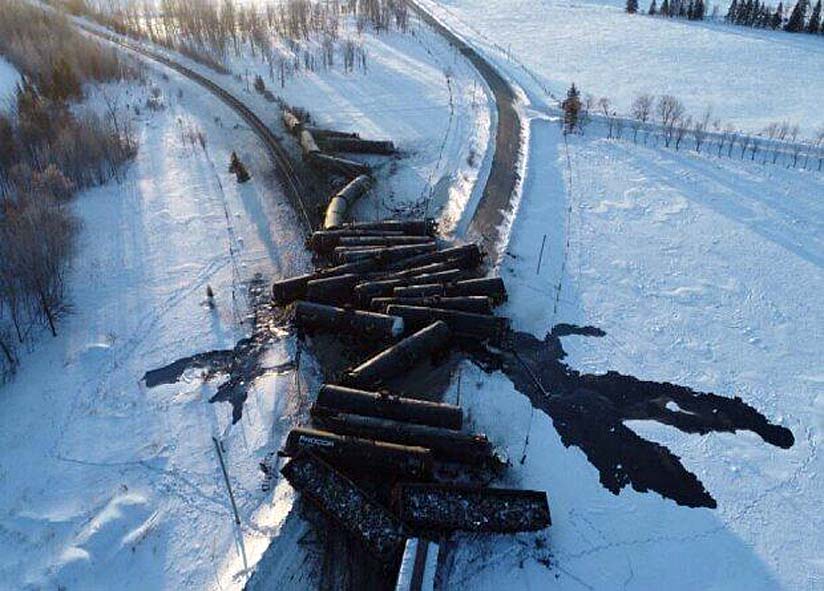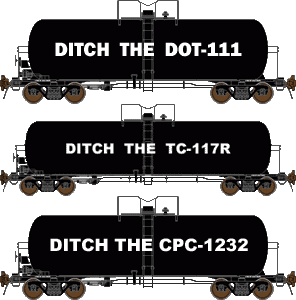
 Guernsey
Saskatchewan - It's been nearly three months since the first of two Canadian Pacific (CP) oil trains derailed and spilled more than one million litres of
diluted bitumen near the hamlet of Guernsey.
Guernsey
Saskatchewan - It's been nearly three months since the first of two Canadian Pacific (CP) oil trains derailed and spilled more than one million litres of
diluted bitumen near the hamlet of Guernsey.
After the second crash, on 6 Feb 2020 Transport Canada (TC) ordered all large trains hauling dangerous goods across the country to slow down.
The department also announced it would work with railway companies to develop new permanent safety measures focused on infrastructure maintenance and winter
operations.
But questions remain about those measures, as well inspections of the Guernsey track prior to the recent derailments there.
What Were the Non-Compliances Found on the CP Track Near Guernsey?
Transport Canada still won't say.
The Sutherland subdivision track that the Guernsey derailments happened on was inspected three times in the last year, twice before the first derailment on
9 Dec 2019 and again after that derailment.
During the first two inspections, which took place on 7 May 2019 and 27 Aug 2019, "minor non-compliances" were found on the track.
But what exactly were those non-compliances?
When CBC News initially asked the question on 12 Feb 2020 TC referred the question to CP, which didn't answer the question, either.
CBC News again asked the regulator for details more recently.
"Results of our inspections contain third-party information so we are not able to disclose them outside of the access to information process," said
Simon Rivet, a TC spokesperson.
In general, non-compliances don't have an immediate impact on rail safety, "which is why TC allows railways 30 days to undertake corrective action,"
Rivet said.
Why is the Safety Review Partly Focused on Track Maintenance Then?
Because the ministry says it must take an "all-encompassing approach," Rivet said.
According to the Rivet, "The key risks factors associated with the transportation of dangerous goods by rail involve, 1) the speed a train is travelling,
2) the nature of the infrastructure over which a train travels, 3) the weather conditions, namely temperature, and 4) the weight of the
train."
"The speed that a train travels affects the number of cars that derail during an accident and the longer and heavier a train is, the more cars that can
derail. Breakages in rail are more frequent during periods of severe, cold, temperatures. Reducing the speed of higher risk key trains will reduce the risk of
product release, and the adverse consequences of a train derailment."
Bruce Campbell, the author of a book on the 2013 Lake Megantic rail disaster in Quebec, wonders why there have not been new regulations limiting the weight and
amount of oil trains.
"The Lake Megantic train had 72 cars. Those that are derailing now have over 100 cars," Campbell said.
Will the Public be Involved in the Ministry's Rail Safety Review?
Maybe?
TC wasn't clear in its response.
"TC officials will engage with those required to bring about effective safety measures," Rivet said.
Campbell isn't counting on it.
"Looks like there will be no consultation outside TC and the industry. Will the workers be consulted?" Campbell said.
Are Rail Companies Advised Ahead of Time of Inspections?
Yes, Rivet said, for a simple reason.
"It would be deemed too dangerous to conduct surprise track inspections because of the train movement along various tracks. Schedules can vary greatly and
it is with the safety of inspectors in mind that coordination with rail company is required," Rivet said.
TC sometimes needs help from railway employees during inspections, Rivet added.
TC conducts inspections using one of 10 Track Assessment Vehicles (TAVs) located across the country.
"A TAV is a road-rail vehicle mounted with sensors that complements and supports the rail safety inspector's visual track inspection. This high technology
equipment measures certain track parameters and provides continuous live readings and notifies the inspector when measured parameters are beyond the regulated
requirements," Rivet said.
Have There Been Other Recent Oil Train Derailments in Canada?
At least one, yes.
On 18 Feb 2020, 12 days after the second Guernsey derailment, a Canadian National (CN) train jumped the tracks near Emo, Ontario, spilling an unspecified
amount of crude oil from five tank cars.
Six homes were evacuated.
The Ontario incident recalled the Guernsey derailments in two ways, besides the fact that the train derailed.
The train was travelling at 70.8 kph, compared to the Guernsey train speeds of 72 kph and 68 kph, respectively.
31 cars derailed, compared to the 33 cars and 32 cars in the Guernsey crashes.
The Transportation Safety Board (TSB) is investigating the Ontario crash too.
The type of tank car that broke open and leaked product during second Guernsey derailment, code named TC-117, was touted by TC as the industry standard in
terms of puncture resistance following Lake Megantic.
The TSB has said the performance of those cars has garnered "significant" industry interest.
Trinity Rail, a company that manufactures the cars, has confirmed it is proactively monitoring the situation.
CBC News recently asked CN twice what type of cars it was using during the 18 Feb 2020 Emo incident.
The company did not provide an answer.
Americans Are Watching
The derailments in Canada are on the radar screens of American railway companies, according to Railway Age, a longstanding trade journal centered on the United
States' railway industry.
As the journal pointed out in a piece last week, "In many cases, those unit trains of Canadian crude travel far greater distances in the U.S. than they do
in Canada, heading to refineries or off-loading terminals as far south as California, Texas, and Louisiana."
Unlike Canada, however, U.S. railway regulators have not asked companies to slow down their speeds, the journal reported.
Author unknown.
 The Transport
Canada slow order was lifted sometime after the date of the Guernsey derailment and before the Emo derailment.
The Transport
Canada slow order was lifted sometime after the date of the Guernsey derailment and before the Emo derailment.
provisions in Section 29 of the Canadian
Copyright Modernization Act.

